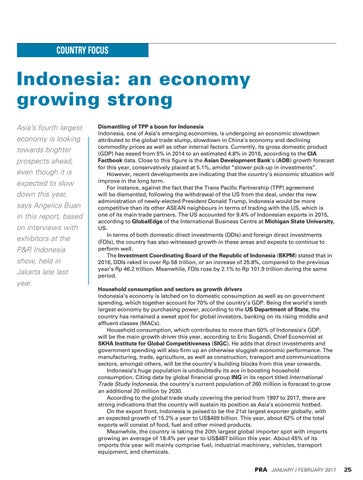Country Focus
Indonesia: an economy growing strong Asia’s fourth largest economy is looking towards brighter prospects ahead, even though it is expected to slow down this year, says Angelica Buan in this report, based on interviews with exhibitors at the P&R Indonesia show, held in Jakarta late last year.
Dismantling of TPP a boon for Indonesia Indonesia, one of Asia’s emerging economies, is undergoing an economic slowdown attributed to the global trade slump, slowdown in China’s economy and declining commodity prices as well as other internal factors. Currently, its gross domestic product (GDP) has eased from 5% in 2014 to an estimated 4.8% in 2016, according to the CIA Factbook data. Close to this figure is the Asian Development Bank's (ADB) growth forecast for this year, conservatively placed at 5.1%, amidst “slower pick-up in investments”. However, recent developments are indicating that the country’s economic situation will improve in the long term. For instance, against the fact that the Trans Pacific Partnership (TPP) agreement will be dismantled, following the withdrawal of the US from the deal, under the new administration of newly-elected President Donald Trump, Indonesia would be more competitive than its other ASEAN neighbours in terms of trading with the US, which is one of its main trade partners. The US accounted for 9.4% of Indonesian exports in 2015, according to GlobalEdge of the International Business Centre at Michigan State University, US. In terms of both domestic direct investments (DDIs) and foreign direct investments (FDIs), the country has also witnessed growth in these areas and expects to continue to perform well. The Investment Coordinating Board of the Republic of Indonesia (BKPM) stated that in 2016, DDIs raked in over Rp 58 trillion, or an increase of 25.8%, compared to the previous year’s Rp 46.2 trillion. Meanwhile, FDIs rose by 2.1% to Rp 101.9 trillion during the same period. Household consumption and sectors as growth drivers Indonesia’s economy is latched on to domestic consumption as well as on government spending, which together account for 70% of the country’s GDP. Being the world’s tenth largest economy by purchasing power, according to the US Department of State, the country has remained a sweet spot for global investors, banking on its rising middle and affluent classes (MACs). Household consumption, which contributes to more than 50% of Indonesia’s GDP, will be the main growth driver this year, according to Eric Sugandi, Chief Economist at SKHA Institute for Global Competitiveness (SIGC). He adds that direct investments and government spending will also firm up an otherwise sluggish economic performance. The manufacturing, trade, agriculture, as well as construction, transport and communications sectors, amongst others, will be the country’s building blocks from this year onwards. Indonesia’s huge population is undoubtedly its ace in boosting household consumption. Citing data by global financial group ING in its report titled International Trade Study Indonesia, the country’s current population of 260 million is forecast to grow an additional 20 million by 2030. According to the global trade study covering the period from 1997 to 2017, there are strong indications that the country will sustain its position as Asia’s economic hotbed. On the export front, Indonesia is poised to be the 21st largest exporter globally, with an expected growth of 15.2% a year to US$469 billion. This year, about 62% of the total exports will consist of food, fuel and other mined products. Meanwhile, the country is taking the 20th largest global importer spot with imports growing an average of 18.4% per year to US$487 billion this year. About 45% of its imports this year will mainly comprise fuel, industrial machinery, vehicles, transport equipment, and chemicals. JANUARY / FEBRUARY 2017
25
